Non-Negligible Influence of Gravel Content in Slip Zone Soil: From Creep Characteristics to Landslide Response Patterns
Abstract
1. Introduction
2. Materials and Methods
2.1. Landslide Overview
2.2. The Large-Scale Direct Shear Creep Tests
3. Results
3.1. Deforming Characteristics
3.2. Stress–Strain Characteristics During Creep
3.3. Long-Term Strength
4. Insights into Micro-Scale Mechanism Using DEM
4.1. Modelling
4.2. Parameter Calibration
4.3. Simulative Results
5. Landslide Deforming Characteristics
6. Conclusions
- (1)
- Gravel content has a significant impact on the creep behavior and strength of slip zone soil. Direct shear creep tests showed that increasing gravel content leads to an enhancement in both the peak shear strength and long-term strength of the slip zone soil. Furthermore, the evolution of the creep curve under different shear stress conditions is closely related to the gravel content.
- (2)
- Distribution and role of gravel within the specimen significantly affect its creep characteristics. Although the gravel in the slip zone does influence the creep displacement, the overall difference in gravel content has a more pronounced effect on the creep behavior of the sample. PFC3D simulations revealed that at approximately 50% gravel content, gravel forms a skeletal structure within the specimen, significantly enhancing its stiffness and strength.
- (3)
- Gravel content significantly influences the displacement characteristics and structural stability of landslides. Coupled PFC3D/FLAC3D simulations showed that the higher the gravel content, the smaller the displacement of the landslide. Under higher gravel content conditions, the structural stability of the landslide body is significantly improved. This study provides a scientific basis for landslide risk assessment and the formulation of prevention measures.
Author Contributions
Funding
Data Availability Statement
Acknowledgments
Conflicts of Interest
References
- Fidan, S.; Tanyaş, H.; Akbaş, A.; Lombardo, L.; Petley, D.N.; Görüm, T. Understanding fatal landslides at global scales: A summary of topographic, climatic, and anthropogenic perspectives. Nat. Hazards 2024, 120, 6437–6455. [Google Scholar] [CrossRef]
- Yang, L.; Wang, Y.; Liao, C.K. Revealing the characteristics and type of chair-shaped landslides considering the reservoir water effect in the Three Gorges Reservoir Area, China. Bull. Eng. Geol. Environ. 2024, 83, 155. [Google Scholar] [CrossRef]
- Li, C.; Fu, Z.; Wang, Y.; Tang, H.; Yan, J.; Gong, W.; Criss, R.E. Susceptibility of reservoir-induced landslides and strategies for increasing the slope stability in the Three Gorges Reservoir Area: Zigui Basin as an example. Eng. Geol. 2019, 261, 10527. [Google Scholar] [CrossRef]
- Jian, W.; Xu, Q.; Yang, H.; Wang, F. Mechanism and failure process of Qianjiangping landslide in the Three Gorges Reservoir, China. Environ. Earth Sci. 2014, 72, 2999–3013. [Google Scholar] [CrossRef]
- Cui, D.; Chen, Q.; Hu, X.; Dai, M.; Liao, M.; Wang, J. Investigation of the creep characteristics of sliding zone soils of reservoir landslides under reservoir water level fluctuations: A case study of the Huangtupo landslide. Landslides 2025, 22, 1241–1255. [Google Scholar] [CrossRef]
- Tang, H.M.; Li, C.D.; Gong, W.P.; Zou, Z.X.; Zhang, Y.Q.; Zhang, S.; Zhang, J.R. Fundamental attribute and research approach of landslide evolution. Earth Sci. 2022, 47, 4596–4608. [Google Scholar]
- Li, Z.; Zhang, H. Influence of particle-size distribution on shear characteristics of slip zone soil and its mesoscopic mechanism. Alex. Eng. J. 2023, 67, 375–396. [Google Scholar] [CrossRef]
- Lu, S.; Tang, H.; Zhang, Y.; Gong, W.; Wang, L. Effects of the particle-size distribution on the micro and macro behavior of soils: Fractal dimension as an indicator of the spatial variability of a slip zone in a landslide. Bull. Eng. Geol. Environ. 2018, 77, 665–677. [Google Scholar] [CrossRef]
- O’Brien, J.; Julien, P. Laboratory analysis of mudflow properties. J. Hydraul. Eng. 1988, 114, 877–887. [Google Scholar] [CrossRef]
- Wang, G.; Sassa, K. Factors affecting rainfall-induced flowslides in laboratory flume tests. Geotechnique 2001, 51, 587–599. [Google Scholar] [CrossRef]
- Jeong, S. Grain size dependent rheology on the mobility of debris flows. Geosci. J. 2010, 14, 359–369. [Google Scholar] [CrossRef]
- Jeong, S.; Locat, J.; Leroueil, S.; Malet, J.P. Rheological properties of fine-grained sediment: The roles of texture and mineralogy. Can. Geotech. J. 2010, 47, 1085–1100. [Google Scholar] [CrossRef]
- Hungr, O.; Leroueil, S.; Picarelli, L. The Varnes classification of landslide types, an update. Landslides 2014, 11, 167–194. [Google Scholar] [CrossRef]
- Parsons, J.D.; Whipple, K.X.; Simoni, A. Experimental study of the grain-flow, fluid-mud transition in debris flows. J. Geol. 2001, 109, 427–447. [Google Scholar] [CrossRef]
- Wen, B.P.; Aydin, A.; Duzgoren-Aydin, N.S.; Li, Y.R.; Chen, H.Y.; Xiao, S.D. Residual strength of slip zones of large landslides in the Three Gorges area, China. Eng. Geol. 2007, 93, 82–98. [Google Scholar] [CrossRef]
- Ren, S.S.; Zhang, Y.S.; Xu, N.X.; Wu, R.A. Mesoscopic response mechanism of residual strength and shear surface roughness of gravelly sliding zone soil. Chin. J. Geotech. Eng. 2021, 43, 1473–1482. [Google Scholar]
- Ren, S.S.; Zhang, Y.S.; Xu, N.X.; Wu, R.A.; Liu, X.Y. Reactivation initiation strength of gravelly sliding zone soil. Rock Soil Mech. 2021, 42, 863–873. [Google Scholar]
- Xu, W.J.; Wang, S. Three-dimensional numerical direct shear test study on meso-mechanics of soil-rock mixtures based on real block morphology. Chin. J. Rock Mech. Eng. 2016, 35, 2152–2160. [Google Scholar]
- Li, Z.; Hua, J.; Yin, P.; Zhang, H. Shear failure analysis of slip zone soil with different coarse particle shapes: Visualized shear test and PIV technology. Eng. Fail. Anal. 2024, 162, 108345. [Google Scholar] [CrossRef]
- He, Y.; Cui, P.; Liao, C.; Zhang, B.; Zhao, Y. Micromorphology of landslide soil: Case study on the Jibazi landslide in Yunyang in the Three Gorges Region. China J. Mt. Sci. 2006, 3, 147–157. [Google Scholar] [CrossRef]
- Gao, W.; Gao, W.; Hu, R.; Xu, P.F.; Xia, J.G. Microtremor survey and stability analysis of a soil-rock mixture landslide: A case study in Baidian town, China. Landslides 2018, 15, 1951–1961. [Google Scholar] [CrossRef]
- Iverson, R.M.; Reid, M.E.; Iverson, N.-R.; LaHusen, R.G.; Logan, M.; Mann, J.E.; Brien, D.L. Acute sensitivity of landslide rates to initial soil porosity. Science 2000, 290, 513–516. [Google Scholar] [CrossRef] [PubMed]
- Yerro, A.; Alonso, E.-E.; Pinyol, N.-M. Run-out of landslides in brittle soils. Comput. Geotech. 2016, 80, 427–439. [Google Scholar] [CrossRef]
- He, Y.; Yu, Z.-P.; Zhang, Z.; Chen, B.; Zhang, K.N. Effects of rainfall on mechanical behaviors of residual-soil landslide. Front. Earth Sci. 2022, 10, 925636. [Google Scholar] [CrossRef]
- Liu, F.Y.; Zheng, Q.T.; Wang, J.; Ying, M.J. Effects of particle shape on shear behaviors of interface between coarse-grained soil and geogrid. J. Mater. Civ. Eng. 2021, 43, 48–56. [Google Scholar]
- Wu, M.M.; Zhou, F.; Wang, J.F. DEM modeling of mini-triaxial test on soil-rock mixture considering particle shape effect. Comput. Geotech. 2023, 153, 105110. [Google Scholar] [CrossRef]
- Yao, Y.S.; Li, J.; Ni, J.J.; Liang, C.H.; Zhang, A.S. Effects of gravel content and shape on shear behaviour of soil-rock mixture: Experiment and DEM modelling. Comput. Geotech. 2022, 141, 104476. [Google Scholar] [CrossRef]
- Yang, B.; Yang, J.; Chang, Z.; Gan, H.Y.; Song, E.X. 3-D granular simulation for compressibility of soil-aggregate mixture. Rock Soil Mech. 2010, 31, 645–1650. [Google Scholar]
- Li, S.; Wang, Y. Stochastic model and numerical simulation of uniaxial loading test for rock and soil blending by 3D-DEM. Chin. J. Geotech. Eng. 2004, 26, 172–177. [Google Scholar]
- Tan, Q.; Huang, M.; Tang, H.; Zou, Z.; Li, C.; Huang, L.; Zhou, X. Insight into the anisotropic deformation of landslide sliding zone soil containing directional cracks based on in situ triaxial creep test and numerical simulation. Eng. Geol. 2022, 311, 106898. [Google Scholar] [CrossRef]
- Wang, H.R.; Huang, H.J.; Liu, F.Y.; Zhang, Z.J.; Qu, Y. Model test and numerical analysis of slope rainfall infiltration considering gravel shape. J. Civ. Environ. Eng. 2025, 1–11. [Google Scholar]
- Liu, F.Y.; Kong, J.J.; Yao, J.M. Effects of stone content and compaction degree on interface shear characteristics of geogrid-soil-rock mixtures. Chin. J. Geotech. Eng. 2023, 45, 903–911. [Google Scholar]
- He, S.J.; Wang, Z.L.; Qu, J.A.; Shen, L.F.; Ding, Z.D. Direct shear creep characteristics and long-term strength experimental study of Kunming peat soil. China Civ. Eng. J. 2019, 52, 16–22. [Google Scholar]
- Cui, K.; Su, L. Influence of coarse particle content on shear strength of mixed soil in western Sichuan. J. Southwest Jiaotong Univ. 2019, 54, 778–785. [Google Scholar]
- Tang, J.Y.; Xu, D.S.; Liu, H.B. Effect of stone content on shear characteristics of soil-rock mixture. Rock Soil Mech. 2018, 39, 93–102. [Google Scholar]
- Xu, W.J.; Hu, R.L.; Tan, R.J.; Zeng, R.Y.; Yu, H.Q. Field experimental study on soil-rock mixture at the right bank of Longpan in Hutiaoxia Gorge. Chin. J. Rock Mech. Eng. 2006, 6, 1270–1277. [Google Scholar]
- Xu, W.J.; Hu, R.L.; Tan, R.J. Some geomechanical properties of soil-rock mixtures in the Tiger-Leaping Gorge area, China. Geotechnique 2007, 57, 255–264. [Google Scholar] [CrossRef]
- Polito, C.P.; Grossman, J.A.; Eldridge, C.; Krawulski, K.; Reils, W.; Shebel, G. Threshold sand content and the behavior of sandgravel mixtures. In Proceedings of the Geo-Congress, Los Angeles, CA, USA, 9–12 March 2023; pp. 293–301. [Google Scholar]
- Liu, C.; Ren, T.Z.; Zhang, R.; Gao, Q.F.; Zheng, J.L. Influence of gradation on resilient modulus of high plasticity soil-gravel mixture. Adv. Civ. Eng. 2020, 1, 8887628. [Google Scholar] [CrossRef]
- Jiang, Z.S.; Gou, Z.L. Analysis of the influence of stone content in residual slope soil-gravel mixtures of the Nairobi-Malaba Railway on shear strength. Subgrade Eng. 2020, 1, 49–54. [Google Scholar]
- Yoon, J. Application of experimental design and optimization to PFC model calibration in uniaxial compression simulation. Int. J. Rock Mech. Min. Sci. 2007, 44, 871–889. [Google Scholar] [CrossRef]
- Carr, M.J.; Roessler, T.; Robinson, P.W.; Otto, H.; Richter, C.; Katterfeld, A.; Wheeler, C.A. Calibration procedure of discrete element method (DEM) parameters for wet and sticky bulk materials. Powder Technol. 2023, 429, 118919. [Google Scholar] [CrossRef]
- Tan, Q.; Tang, H.; Fan, L.; Xiong, C.; Fan, Z.; Zhao, M.; Zou, Z. In situ triaxial creep test for investigating deformational properties of gravelly sliding zone soil: Example of the Huangtupo 1# landslide, China. Landslides 2018, 15, 2499–2508. [Google Scholar]
- Tang, H.; Wasowski, J.; Juang, C.H. Geohazards in the Three Gorges Reservoir Area, China–lessons learned from decades of research. Eng. Geol. 2019, 261, 105267. [Google Scholar] [CrossRef]
- Li, D.D.; Hu, H.R.; Xiao, M. Tunnel excavation and bolt support particle flow model based on PFC-FLAC discretecontinuous coupling analysis. Eng. J. Wuhan Univ. 2024, 57, 286–294. [Google Scholar]
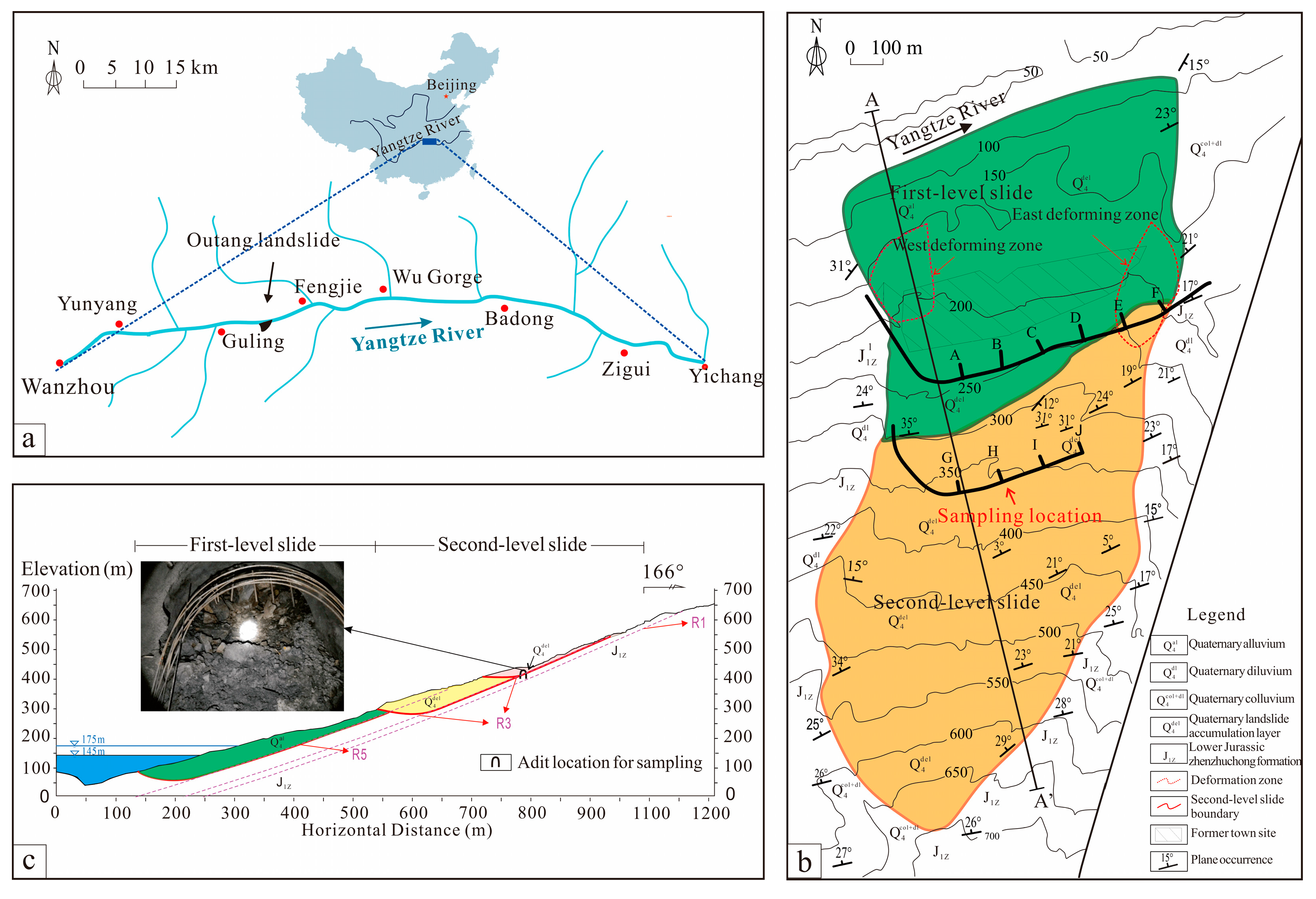
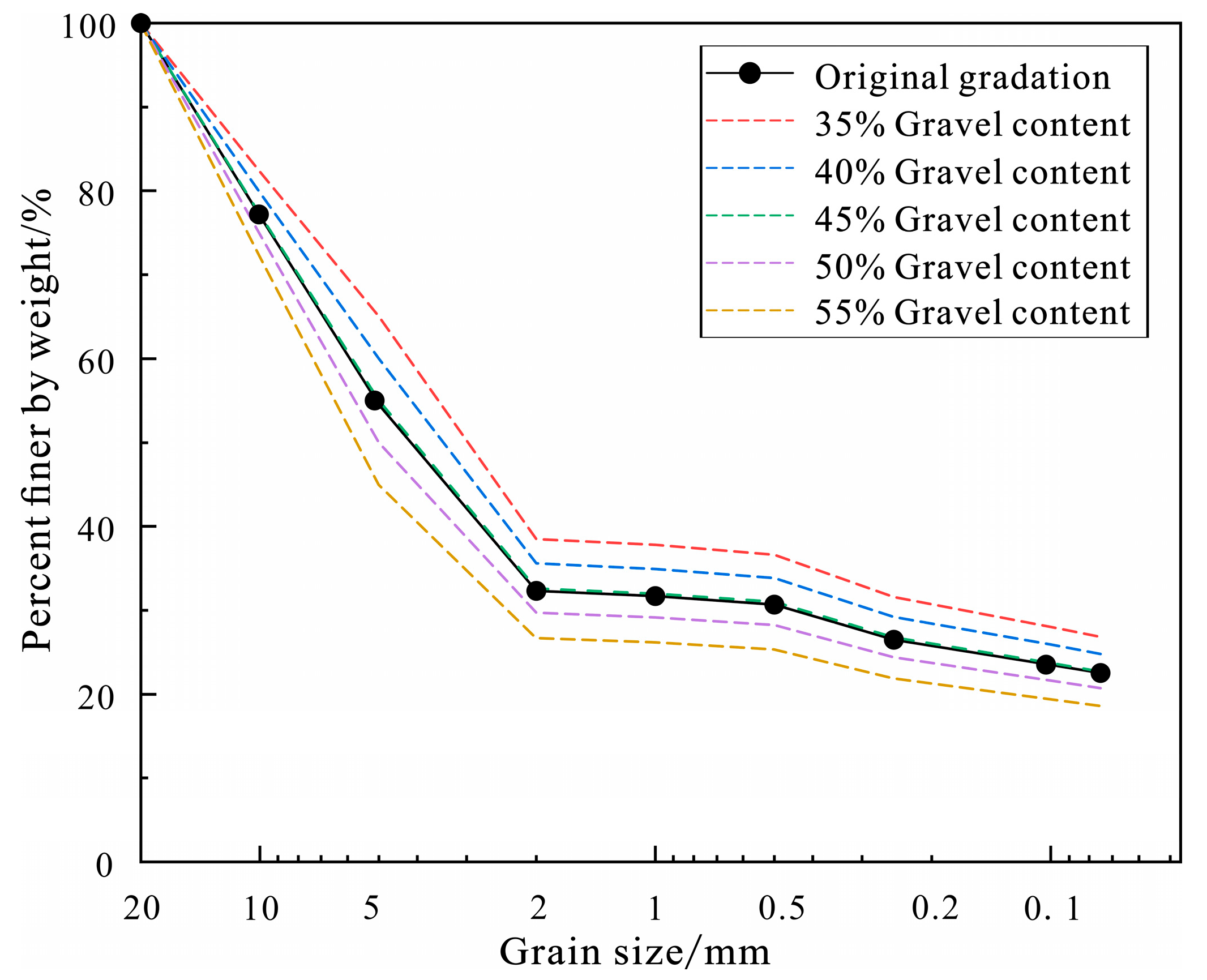
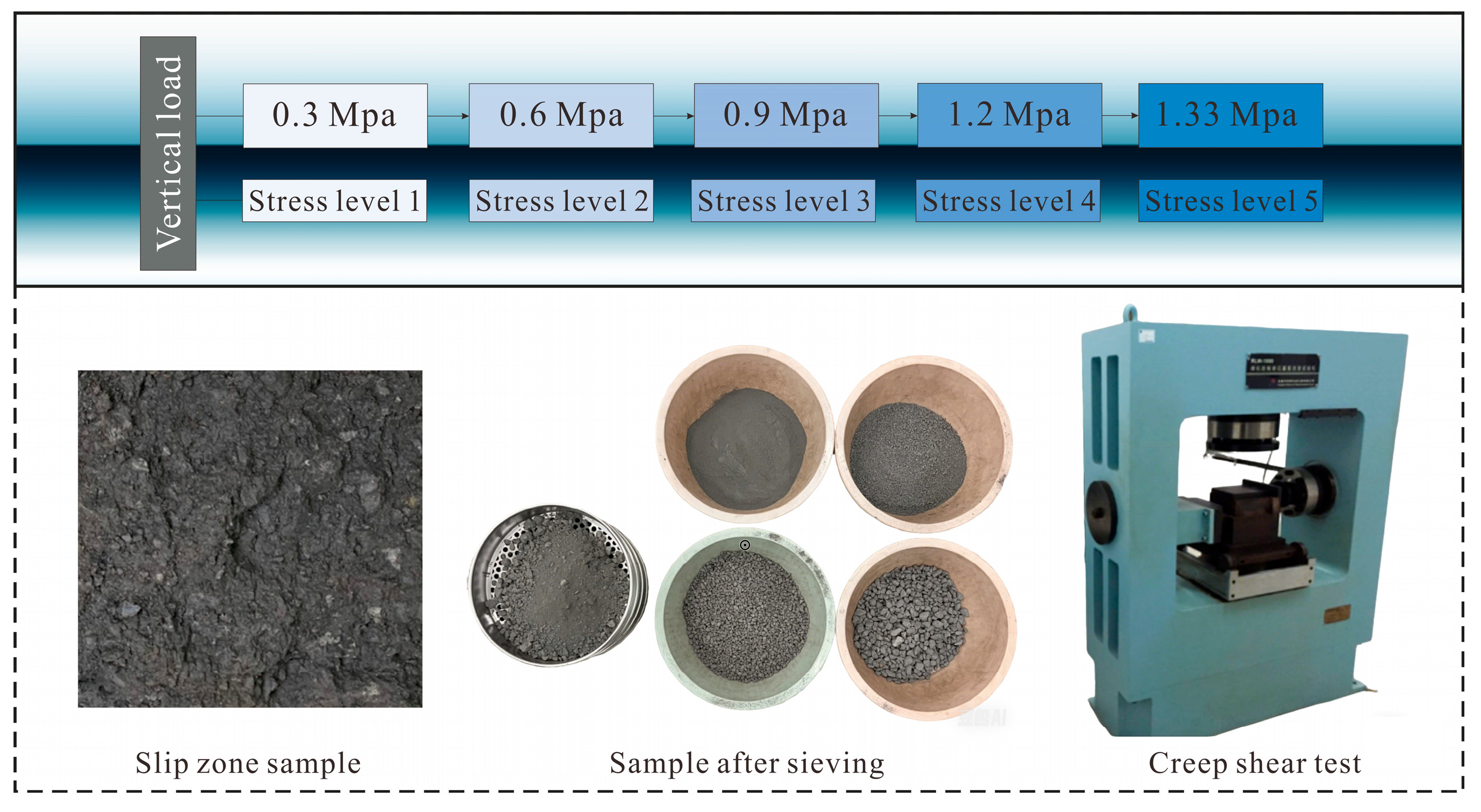
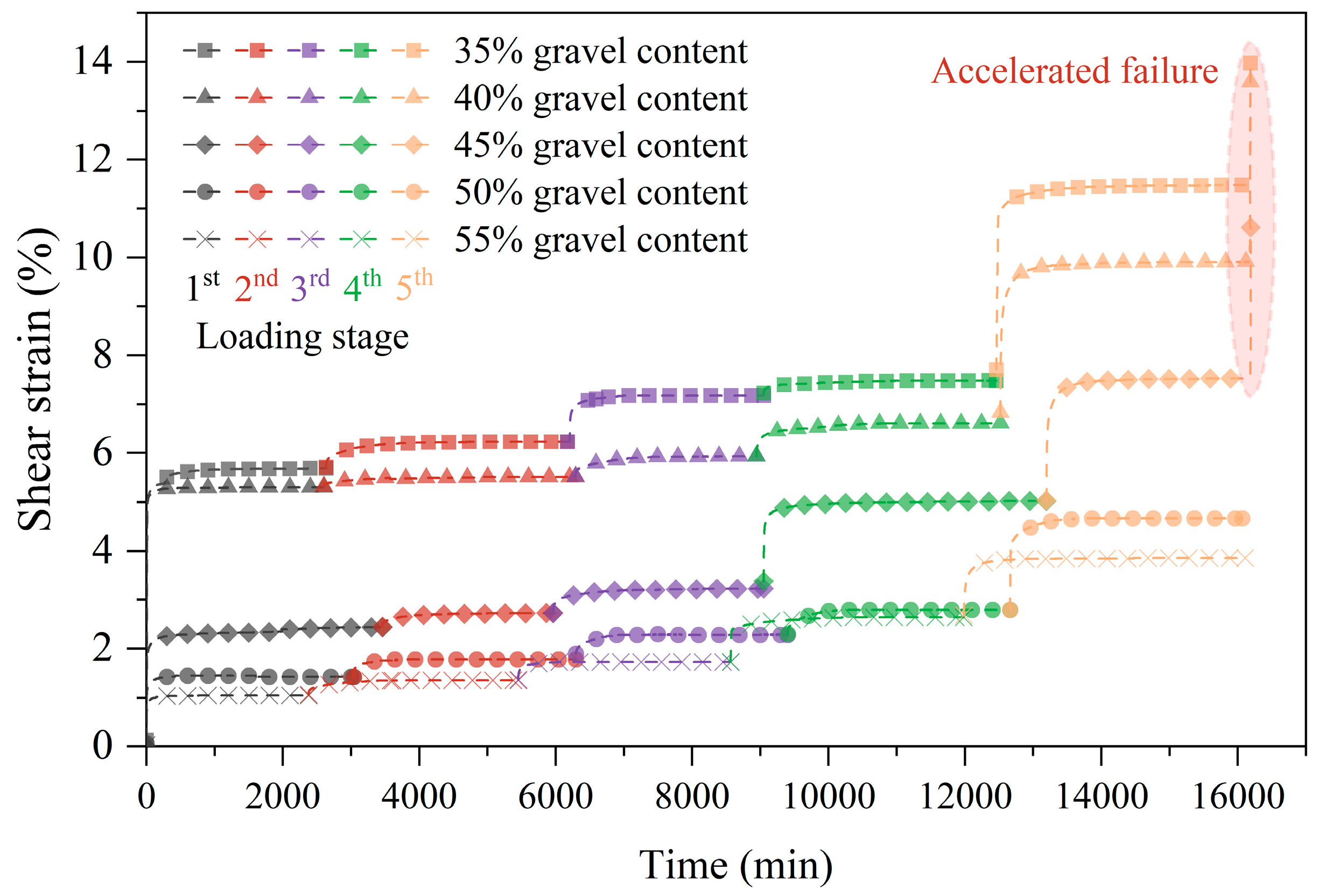
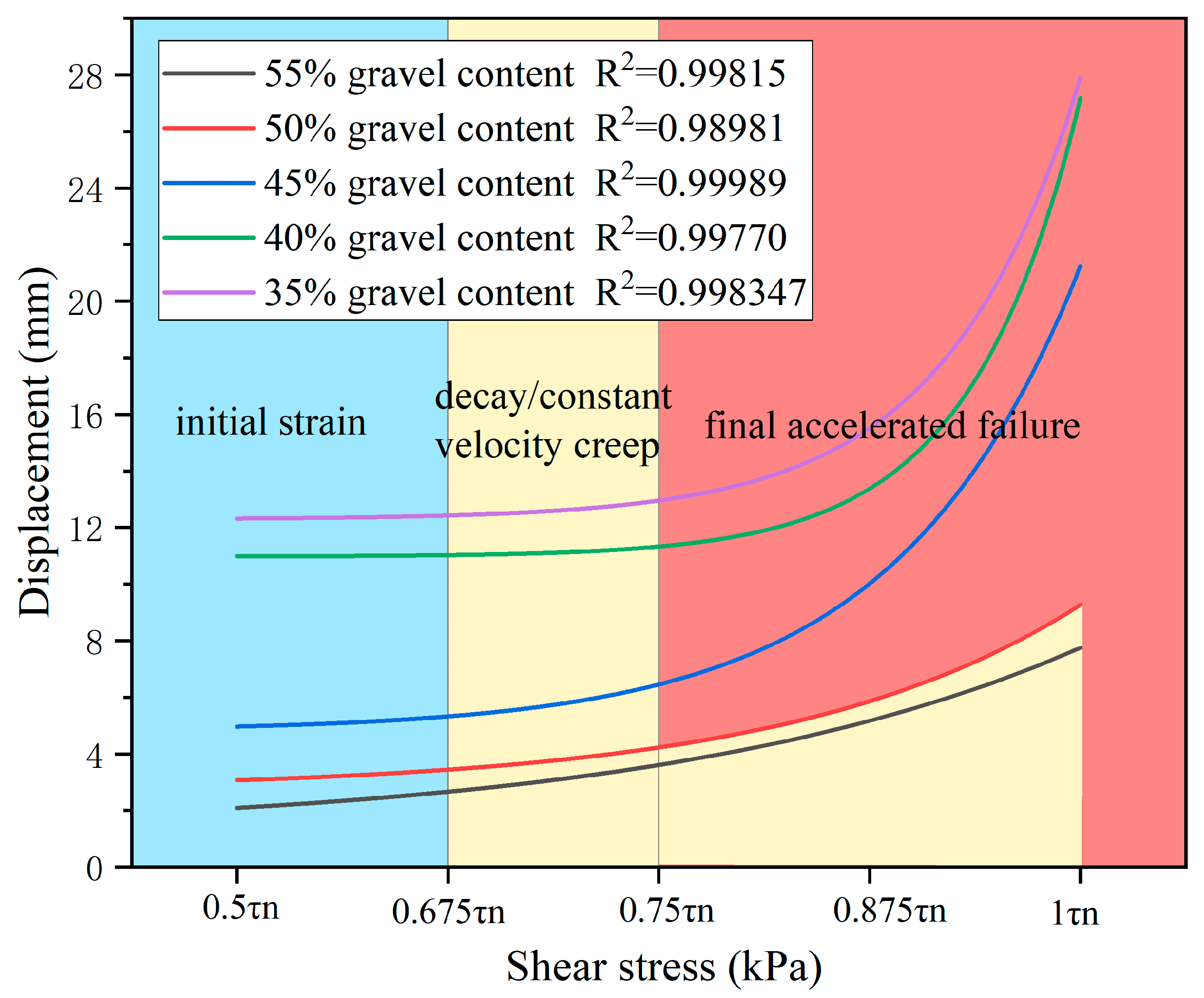
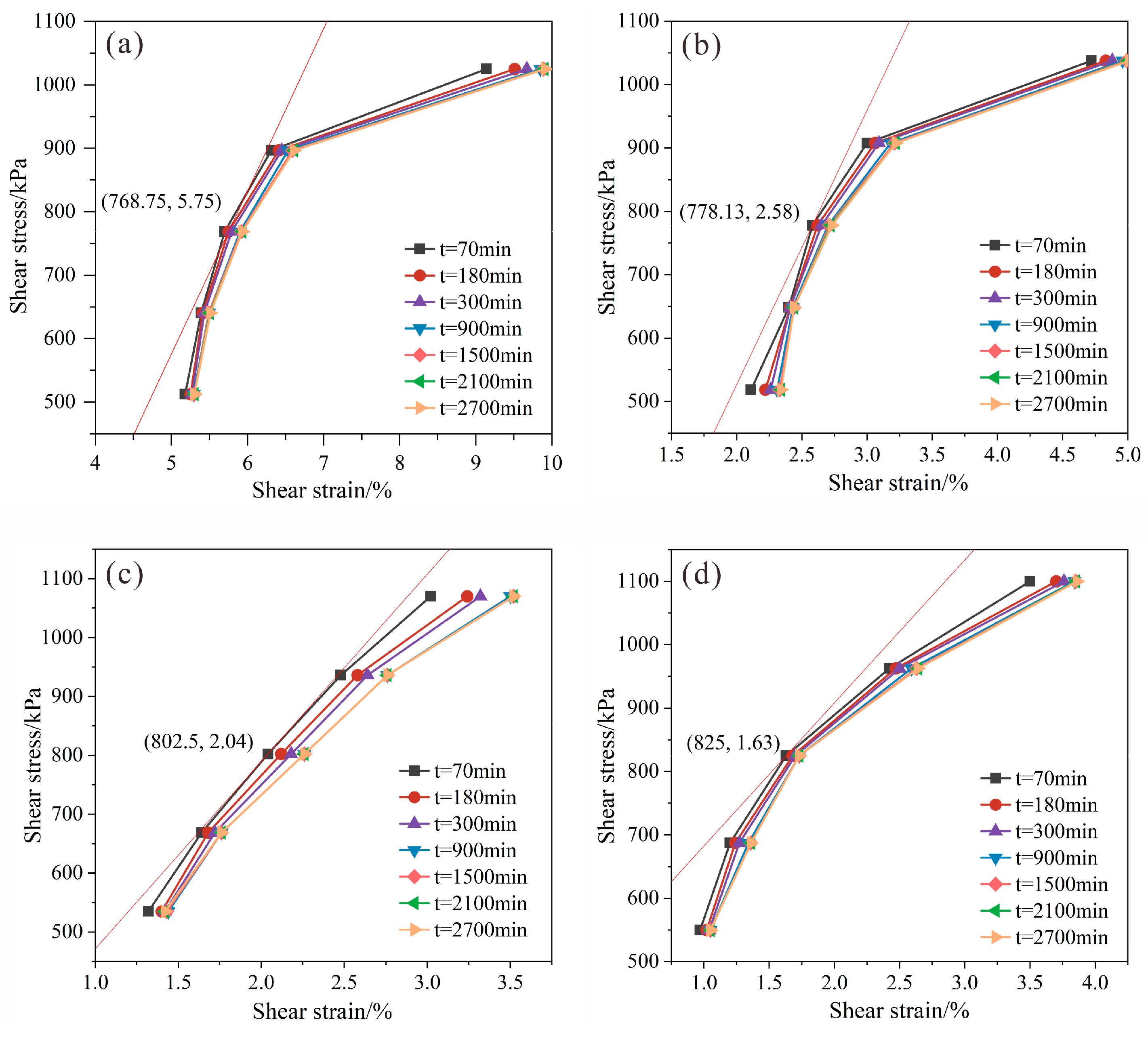

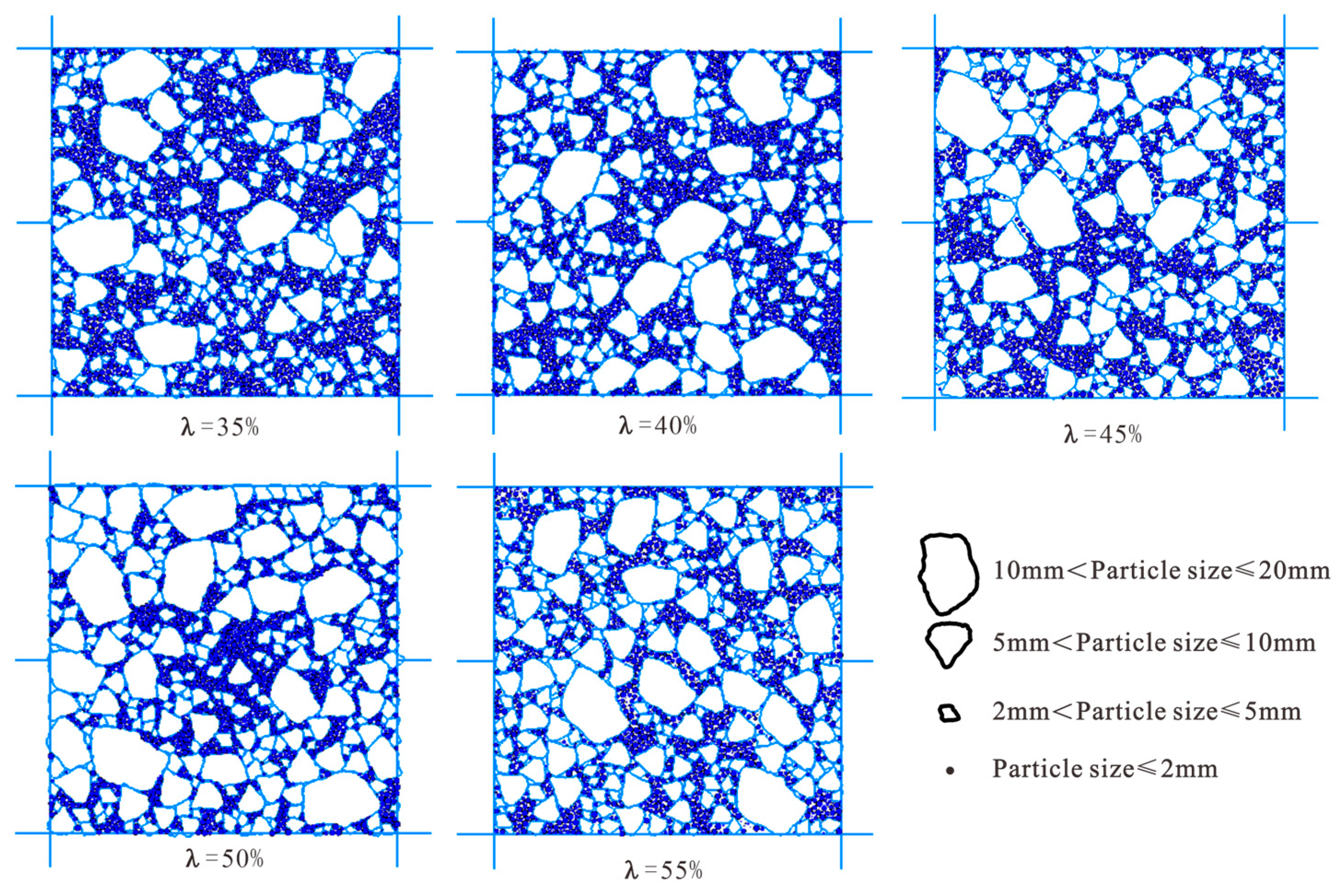
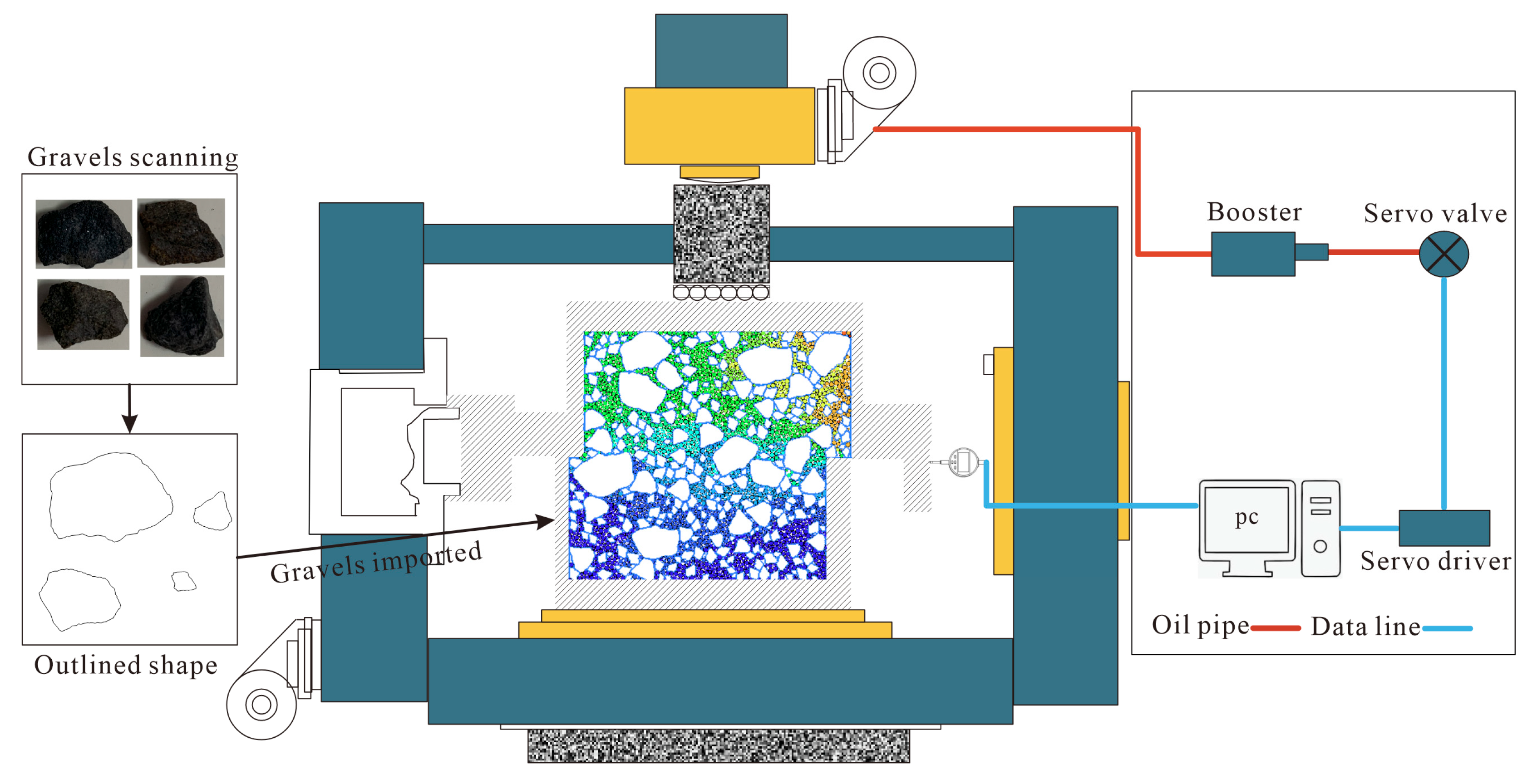


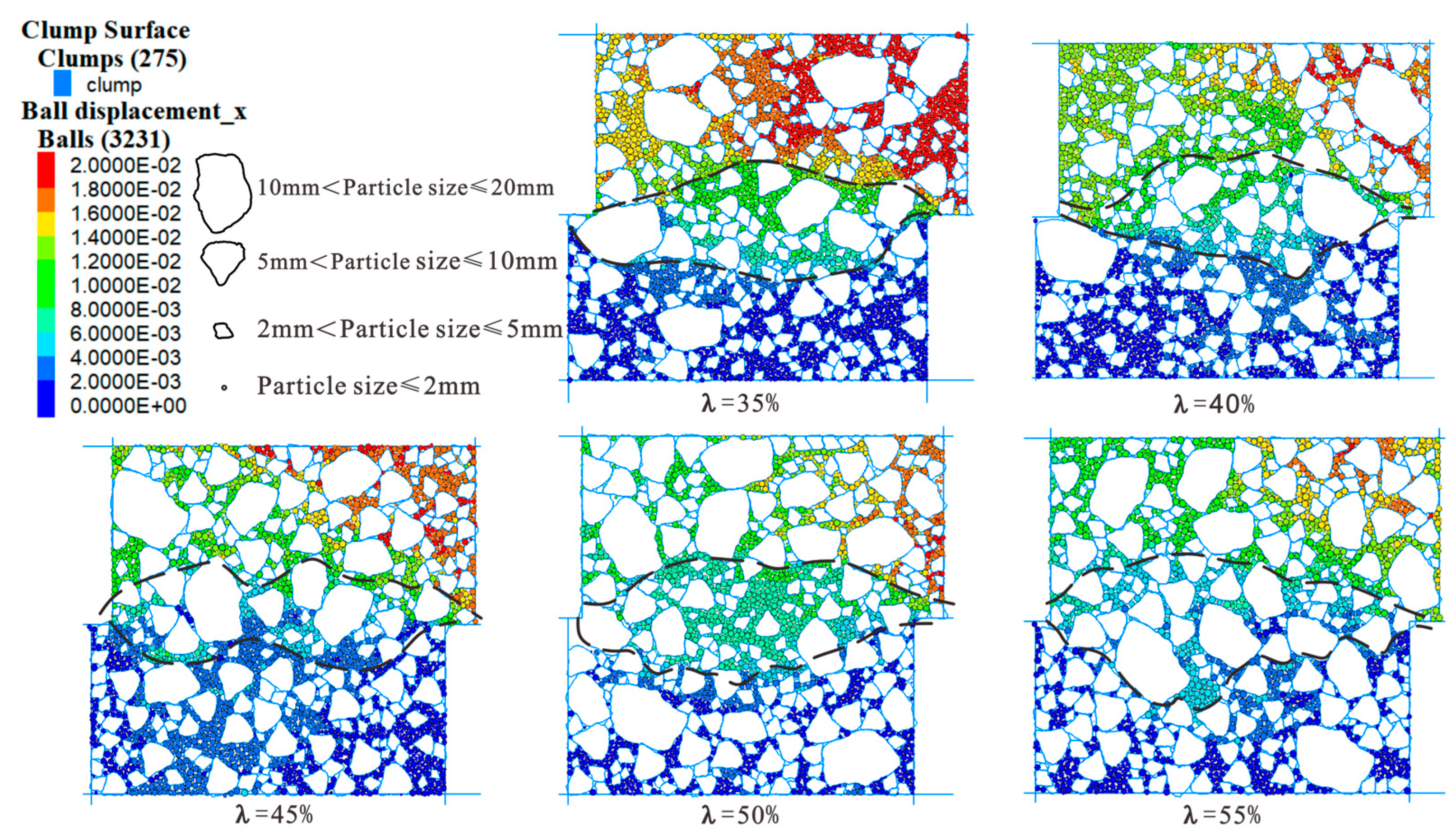


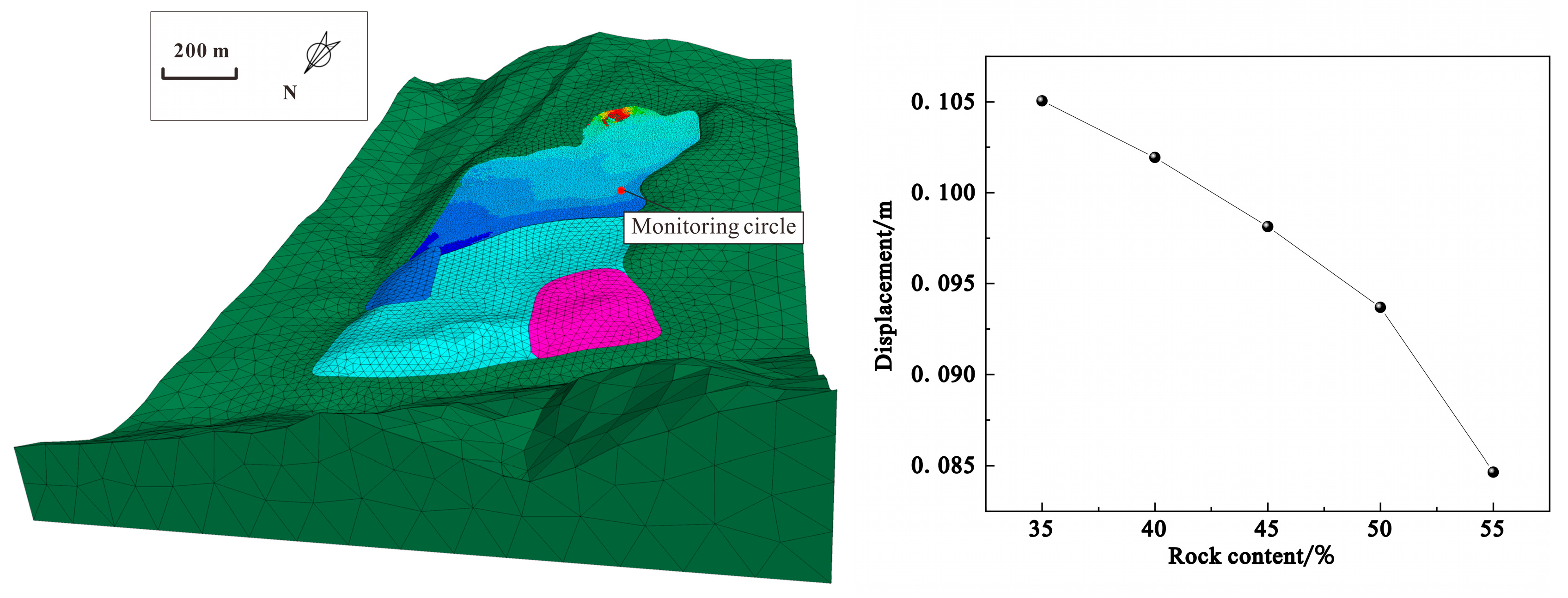
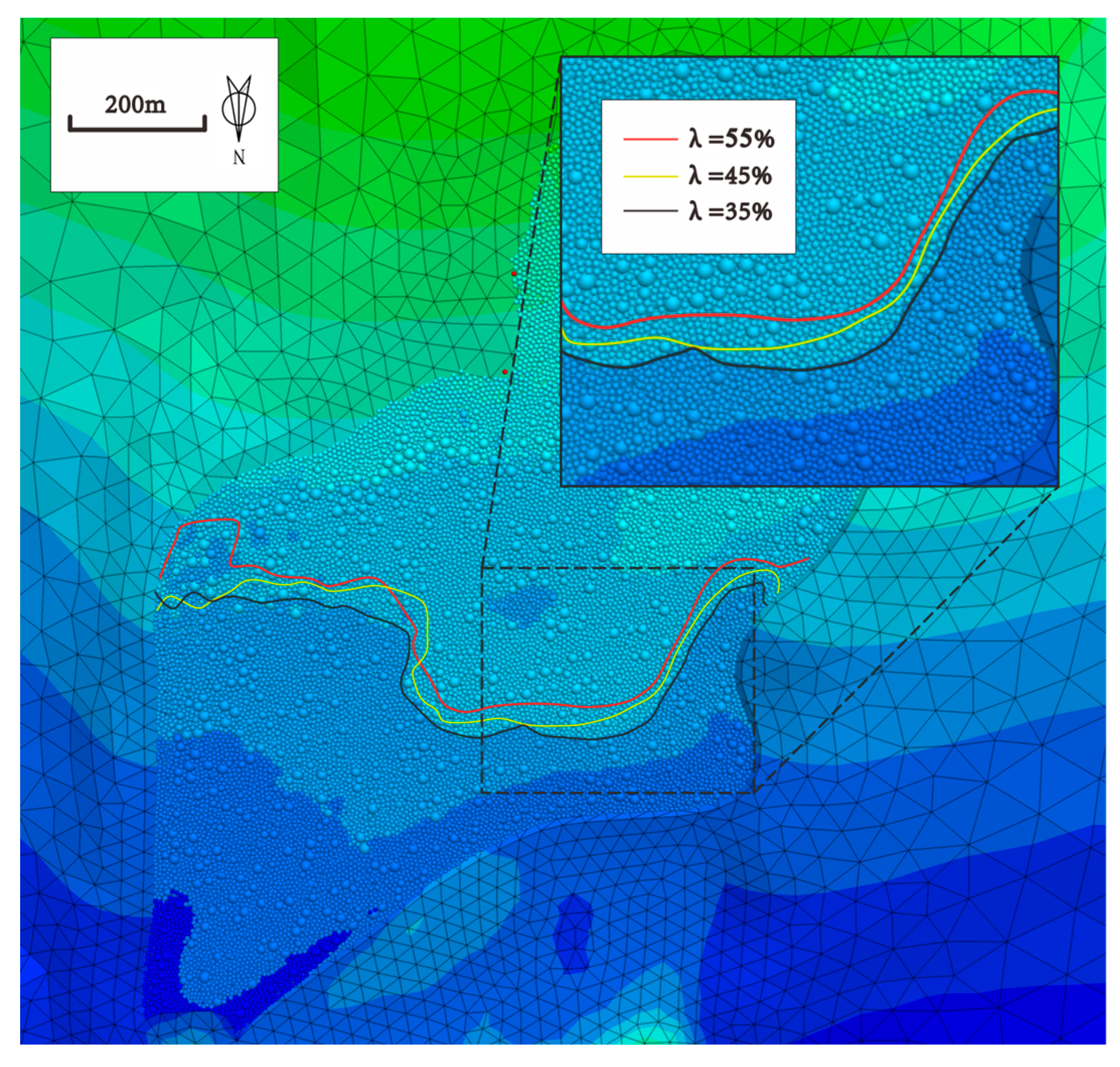

| Gravel Content (%) | Primary Stage Strain (%) | Secondary Stage Strain (%) | Tertiary Stage Strain (%) | Creep Beheavior | |||||
|---|---|---|---|---|---|---|---|---|---|
| 1st Loading | 2nd–4th Loading | 5th Loading | |||||||
| 35 | 5.69 | 6.23 | 7.18 | 7.55 | 13.98 | Large initial strain; small increments during decay stage; rapid transition to accelerated creep at the 5th load level | |||
| 40 | 5.30 | 5.51 | 5.93 | 6.61 | 13.95 | Slightly reduced initial strain; slow increase in increments during decay stage; accelerated failure at the 5th load level | |||
| 45 | 2.45 | 2.74 | 3.22 | 5.03 | 10.60 | Significantly decreased initial strain; increasing increments during decay stage; accelerated failure at the 5th load level | |||
| - | - | 2nd–5th loading | - | - | |||||
| 50 | 1.32 | 1.73 | 2.28 | 2.79 | 4.67 | None | Small initial strain; smooth transition between decay and constant velocity stages; no accelerated failure | ||
| 55 | 1.05 | 1.37 | 1.73 | 2.64 | 3.86 | None | Minuscule initial strain; gentle creep process without acceleration | ||
| Parameter | Value |
|---|---|
| Particle parameters | |
| Density (kg/m3) | 2240 |
| Effective modulus (E*/Gpa) | 0.2 |
| Normal - Shear stiffness ratio (kn/ks) | 1.5 |
| Friction coefficient μ | 0.5 |
| Test parameters | |
| Effective modulus (E*/Gpa) | 0.2 |
| Normal - Shear stiffness ratio (kn/ks) | 1.5 |
| Normal stress (kPa) | 1328 |
| Shear stress (kPa) | Graded loading |
| Simulated Material | Unit Weight (kN/m3) | Cohesion (kPa) | Friction Angle (°) | Elastic Modulus (MPa) | Poisson’s Ratio |
|---|---|---|---|---|---|
| Bedrock | 26.7 | 8300 | 41.7 | 1.88×104 | 0.19 |
| First-level landslide | 20.1 | 28 | 20.5 | 200 | 0.15 |
| Second-level landslide | 21.8 | 35.1 | 26.4 | 200 | |
| East deformation zone | 20.4 | 45.9 | 15.6 | 200 | |
| Western deformation zone | 20.4 | 45.9 | 15.6 | 200 |
Disclaimer/Publisher’s Note: The statements, opinions and data contained in all publications are solely those of the individual author(s) and contributor(s) and not of MDPI and/or the editor(s). MDPI and/or the editor(s) disclaim responsibility for any injury to people or property resulting from any ideas, methods, instructions or products referred to in the content. |
© 2025 by the authors. Licensee MDPI, Basel, Switzerland. This article is an open access article distributed under the terms and conditions of the Creative Commons Attribution (CC BY) license (https://creativecommons.org/licenses/by/4.0/).
Share and Cite
Xu, B.; Zhao, X.; Yuan, J.; Dong, S.; Du, X.; Yang, L.; Peng, B.; Tan, Q. Non-Negligible Influence of Gravel Content in Slip Zone Soil: From Creep Characteristics to Landslide Response Patterns. Water 2025, 17, 1726. https://doi.org/10.3390/w17121726
Xu B, Zhao X, Yuan J, Dong S, Du X, Yang L, Peng B, Tan Q. Non-Negligible Influence of Gravel Content in Slip Zone Soil: From Creep Characteristics to Landslide Response Patterns. Water. 2025; 17(12):1726. https://doi.org/10.3390/w17121726
Chicago/Turabian StyleXu, Bo, Xinhai Zhao, Jin Yuan, Shun Dong, Xuhuang Du, Longwei Yang, Bo Peng, and Qinwen Tan. 2025. "Non-Negligible Influence of Gravel Content in Slip Zone Soil: From Creep Characteristics to Landslide Response Patterns" Water 17, no. 12: 1726. https://doi.org/10.3390/w17121726
APA StyleXu, B., Zhao, X., Yuan, J., Dong, S., Du, X., Yang, L., Peng, B., & Tan, Q. (2025). Non-Negligible Influence of Gravel Content in Slip Zone Soil: From Creep Characteristics to Landslide Response Patterns. Water, 17(12), 1726. https://doi.org/10.3390/w17121726






